Marvel Rivals Tournament Format Guide: Everything You Need to Know
Updated On: October 23, 2025 by Aaron Connolly
Core Tournament Structure
Marvel Rivals tournaments stick to a pretty standard format with a few distinct phases. Organizers use these to keep things organized, from small local events all the way to the Marvel Rivals Championship.
The setup includes qualifying rounds, bracket progression, and match formats that really put team coordination to the test.
Format Overview
Most Marvel Rivals tournaments run on a double-elimination bracket system. So, if your team loses once, you still get a shot to fight your way back.
The Marvel Rivals Championship (MRC) sits at the top as the main event each quarter. Rules and requirements can change a bit with each season, so you’ll want to keep an eye out.
Tournaments usually support cross-platform play, so PC, console, and mobile players can all jump in together. Teams sign up through official platforms, but you’ll need to meet the eligibility rules.
Tournament sizes shift a lot. You might see small events with just 8-16 teams, or massive championships with hundreds. Registration is pretty simple—just fill out a form, either online or on paper.
Tournament Phases
Marvel Rivals tournaments move through a few key phases. Qualifying stages kick things off, with most teams battling for a spot in the next round.
Any eligible team can enter open qualifiers. These usually use Swiss-system rounds or group stages to whittle down the competition.
Semi-final and final stages get the full broadcast treatment at big events like the MRC. Earlier matches might only get streamed if there’s enough interest.
Organizers decide which matches to stream based on how many people might tune in. They’ll announce the streaming schedule ahead of time.
Phase timing matches up with the game’s seasonal schedule. The Marvel Rivals Championship pops up every quarter, so teams can plan out their year.
Match Types and Rounds
Standard Marvel Rivals tournament matches use best-of-three (Bo3) formats for most rounds. Finals crank it up to best-of-five (Bo5) for extra drama.
Matches run on official tournament game modes and map rotations. Teams can’t change these during competition.
Round structure goes from group stages straight into knockout brackets. Swiss-system tournaments might use points for advancement instead.
Teams have to use registered players with verified accounts in good standing. Substitutions are allowed, but only under strict rules and time limits.
Technical requirements include a stable internet connection and approved hardware. Organizers can tweak rules if needed to keep things fair.
Qualifiers Explained
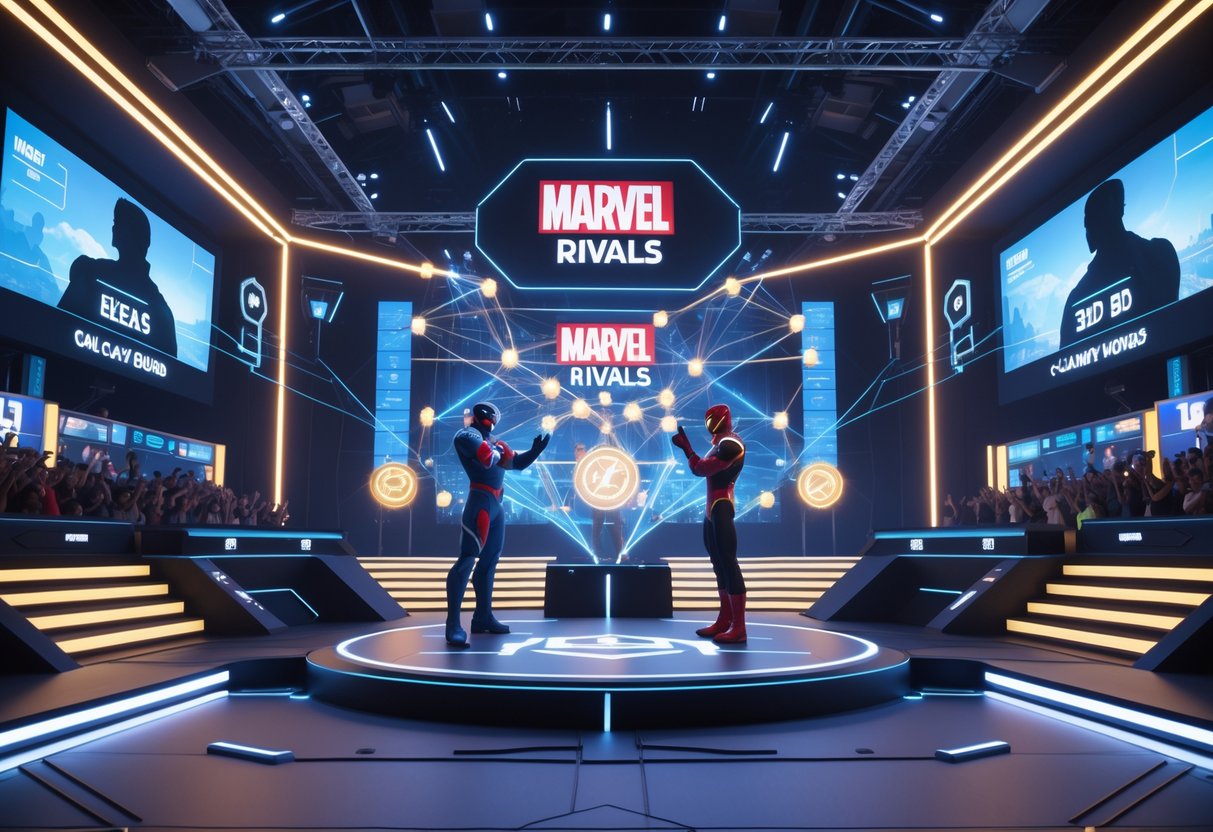
Qualifiers are where competitive Marvel Rivals teams start their journey to the big tournaments. Teams go through open qualifiers first, and the top performers move on to closed qualifiers before hitting the main playoff bracket.
Open Qualifiers Format
Open qualifiers use a Best of 1 (Bo1) format, and the game picks maps at random from the competitive pool. Each faction can play up to 10 qualifier matches during the qualifying window.
The scoring is simple: 3 points for a win, 0 points for a loss. Ties don’t count for your total matches or points.
Registration Requirements:
- At least 6 players per faction
- Players must hit the season’s rank requirements
- Age: 18+ in China, 16+ elsewhere
- Up to 2,000 factions per region
Rankings are based on points first. If teams tie, matches completed come next, then total win time, kills, and finally damage.
The top 128 factions go straight to the double-elimination stage. Teams ranked 129-512 get another shot in closed qualifiers.
Closed Qualifiers Process
Closed qualifiers stick with the Bo1 format from opens. Teams that finished 129th-512th in opens get a second chance to qualify for playoffs.
Factions can play another 10 matches in closed qualifiers. The same 3-points-per-win system applies.
Rankings and tiebreakers are exactly the same as in open qualifiers. It’s points, then matches, win time, kills, and damage.
Only the top 128 teams from closed qualifiers make it to the double-elimination playoff bracket. These teams grab seeds 129-256 for the playoffs.
The qualifying period usually lasts 2-3 weeks. For example, Marvel Rivals Ignite 2025 ran qualifiers from May 15-31, so teams had plenty of time to get their matches in.
Advancement Pathways
Teams have two main ways to reach the main bracket. Direct qualification through open qualifiers rewards the best early performers.
Direct Path: Finish top 128 in opens → Playoff bracket (seeded 1-128)
Secondary Path: Place 129-512 in opens → Closed qualifiers → Top 128 advance to playoffs (seeded 129-256)
Seeding really matters for your playoff matchups. Higher-ranked teams from opens face lower seeds from closed qualifiers in the first rounds.
Teams that don’t qualify through either path are out for that season. But since the Marvel Rivals Championship runs every quarter, there’s always another shot coming up.
Quick tip: Play all 10 qualifier matches. Even if you start rough, you can still rack up points and climb the rankings.
Double Elimination Stage
The double elimination format lets teams recover from a single loss, so you get more competitive matches and fairer results. Teams move through upper and lower brackets, with match lengths changing depending on where you are in the tournament.
Seeding and Bracket Progression
128 teams qualify for the Marvel Rivals Championship double elimination stage. The top 128 from open qualifiers go straight in, while teams ranked 129-512 have to fight through closed qualifiers.
Organizers use random seeding for the initial bracket. That’s a bit different from some esports, where seeds are based on rankings.
If your team loses once, you still have a shot at winning the whole thing. Upper bracket teams need fewer wins to make the finals, while lower bracket teams are always one loss away from elimination.
Here’s how it works:
- Win in the upper bracket? You move to the next round up top.
- Lose in the upper bracket? You drop to the lower bracket.
- Lose in the lower bracket? That’s it—you’re out.
Quick win: Learn the bracket layout before your matches. Whether you’re in upper or lower bracket changes how you approach the day.
Upper and Lower Brackets
Upper bracket teams get the benefit of needing fewer wins. They can take a loss and keep going. They also usually play fewer matches, so fatigue isn’t as big a deal.
Lower bracket is where things get intense. One more loss and your tournament is over. These matches are often the most exciting to watch because teams have everything on the line.
The lower bracket is longer. Teams can enter at different points, depending on when they drop out of the upper bracket. If you lose early, you’ll have to grind through more matches to survive.
Warning: Lower bracket teams might play several matches in a single day. That can really wear you down for the later rounds.
The bracket wraps up when the upper bracket winner faces off against the lower bracket winner. If the lower bracket team wins, they play again right away since both teams need one loss.
Best-of Series Details
Match formats change as the tournament goes on:
| Stage | Format | Matches to Win |
|---|---|---|
| Rounds 1-9 | Best-of-3 (BO3) | First to 2 |
| Rounds 10-14 | Best-of-5 (BO5) | First to 3 |
| Lower Bracket Finals | Best-of-7 (BO7) | First to 4 |
| Grand Finals | Best-of-7 (BO7) | First to 4 |
BO3 matches in the early rounds keep things moving fast. Teams don’t get much time to adjust between maps.
BO5 and BO7 formats add more depth. Teams can really adapt and change strategies mid-series. These longer sets usually give us a clearer winner.
Map selection follows official competitive rules. The first map and sides are picked at random, then teams alternate picks and bans for the rest.
Finals and Grand Finals Format
Finals use longer match formats to make sure the best team wins. Grand finals usually run best-of-seven (BO7), and lower bracket finals use the same in major tournaments.
Lower Bracket Finals
Teams dropping from the upper bracket get one last shot here. The lower bracket finals usually run as a best-of-seven in big Marvel Rivals events like Championship Season 1.
This longer format gives teams room to adjust strategies. Matches tend to be closer since both squads have already battled through tough rounds.
What’s different from earlier rounds:
- BO7 format instead of BO3 or BO5
- Elimination is right there on the line
- More time for tactical changes between maps
The winner moves on to face the upper bracket champ. If the grand final uses a bracket reset, they’ll need to win two BO7 series to take the title.
Teams often pull out their wildest strats at this point. Expect some off-meta hero picks and creative team comps as they fight to stay alive.
Grand Final Showdown
Grand finals use the longest format—best-of-seven matches in top-tier events. Both teams get every chance to show off their full range.
Marvel Rivals Championship grand finals always stick to this BO7 setup. It really tests who can adapt over lots of maps and modes.
Some tournaments use bracket reset rules. If the lower bracket team wins the first BO7, they play another right away to decide it all. That keeps things fair for the upper bracket team, since they haven’t lost yet.
Prize pools hit their peak here:
- Marvel Rivals Ignite throws down $1 million total
- Championship events give the biggest shares to finalists
- Streaming numbers always spike for these matches
Teams come in with specific map strategies just for grand finals. Picks and bans become even more important, as everyone tries to force their opponents onto uncomfortable ground.
Tournament Registration Requirements
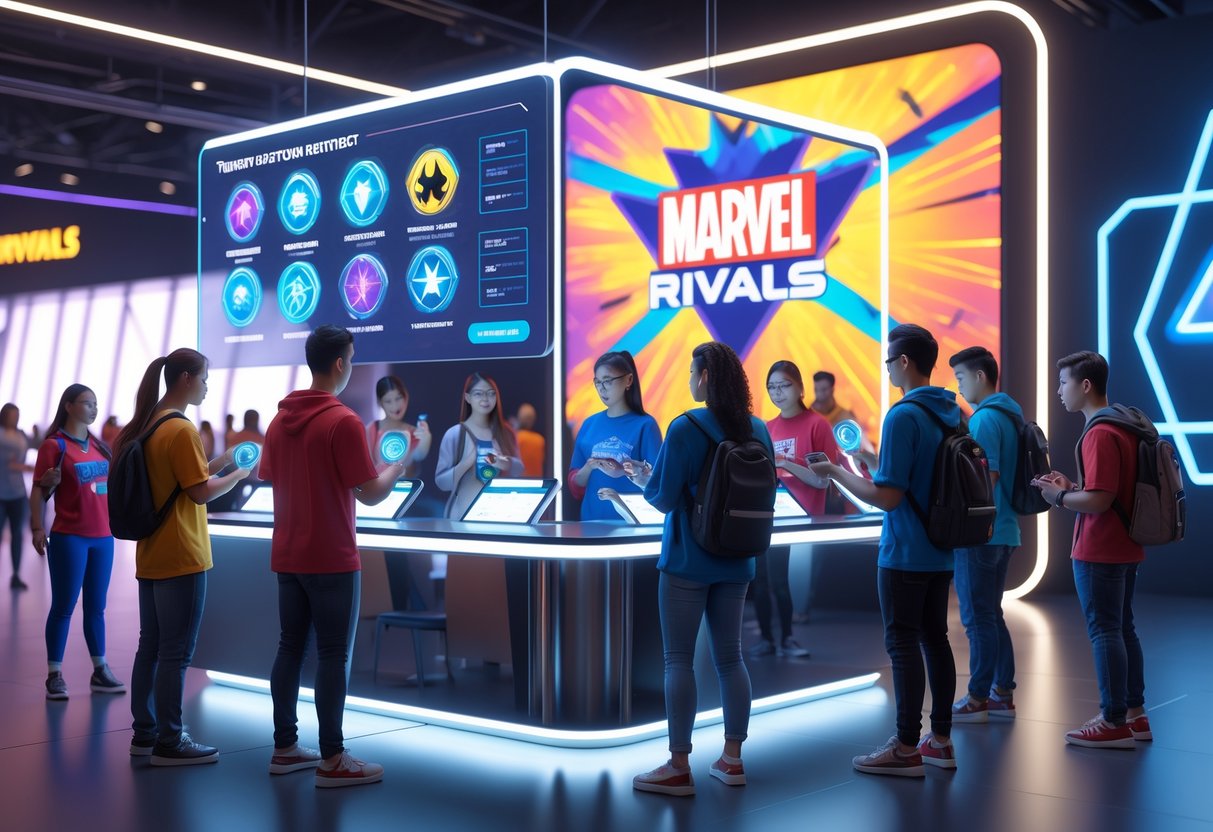
Getting into Marvel Rivals tournaments means you have to meet certain requirements and go through the registration process. Most tournaments use the in-game system, but eligibility rules and team needs can change from event to event.
Eligibility Criteria
Most official Marvel Rivals tournaments require players to be at least 13 years old to join the Marvel Rivals Championship (MRC).
Some tournaments limit who can sign up by region. For example, the Ignite 2025 Tournament only lets PC players register—console players can’t get in for that one.
You’ll need to fill out a participation confirmation form. Depending on the tournament, this could be paper or digital. For official Marvel Rivals events, you can’t skip this step.
Heads up: Tournaments sometimes update their eligibility rules between seasons. The Marvel Rivals Championship changes requirements every quarter, so double-check the latest tournament rules before signing up.
Account standing matters. If you’ve been banned or have recent violations, you might get excluded from official competitions.
Rank and Team Size
Marvel Rivals tournaments use different setups for team requirements. Most events go with a bracket system, sometimes for solo players, sometimes for full teams.
Team-based tournaments need everyone on your squad to register together. Every player has to meet the eligibility criteria. You can’t mix players from restricted regions on one team.
Rank requirements change depending on the tournament. Some are open to any skill level, while others need you to hit a certain rank or have previous tournament experience.
Quick tip: If you’re playing in a custom tournament, organizers set the team size rules. You might see anything from solo play to full squads.
Cross-platform play is usually turned on for Marvel Rivals tournaments. PC, console, and mobile players can all compete together, as long as the rules allow it.
Registration Steps
Go to the official Marvel Rivals website or use the in-game tournament interface. If you don’t have an account yet, create one first.
Registration usually opens a few weeks before each tournament. If you want to catch the sign-up window, follow Marvel Rivals on Twitch, YouTube, Discord, and Twitter for updates.
Here’s how to register:
- Pick your tournament from the list of competitions.
- Fill out the participation confirmation form with accurate info.
- Verify your account through email or in-game pop-up.
- Submit your registration before the deadline hits.
Watch those deadlines—popular tournaments like the Marvel Rivals Championship fill up lightning fast. Late sign-ups almost never get in.
Double-check your details before you submit. Some tournaments don’t allow name changes or roster swaps after registration, so you might get stuck with what you enter.
Regional Divisions and Server Allocation

Marvel Rivals Championship runs events in several regions to keep things fair and servers stable. The tournament structure splits up major gaming markets, and China gets its own division because of local laws.
Participating Regions
The Marvel Rivals Championship holds tournaments in four main regional divisions. This setup keeps matches balanced and reduces lag.
America includes North and South America—so the US, Canada, Mexico, and everywhere south. Teams here play during American peak hours.
EMEA covers Europe, the Middle East, and Africa. Players from the UK, across Europe, and nearby regions all compete together. Matches usually happen in the European evening.
Pacific brings together Australia, New Zealand, Japan, Korea, and Southeast Asia. Honestly, the distances here make things tricky sometimes.
China has its own standalone region. Chinese teams play their own events with different schedules and rules.
This regional system cuts down on ping and connection headaches. Players get matched with others in their time zone, which just makes tournaments more fun for everyone.
China and Other Special Rules
China hosts completely separate Marvel Rivals tournaments because of strict gaming laws. Chinese players can’t join the main Marvel Rivals Championship events outside their region.
The Chinese division runs on its own schedule. Prize pools and broadcast rules work differently too, all because of government regulations.
Special rules for China:
- Different sign-up requirements
- Separate streaming platforms
- Local sponsor limitations
- Tweaked tournament formats
Other regions sometimes add their own small rule changes. Some countries want extra player verification or limit certain features. Teams should check local requirements before signing up.
Special events like the Hellfire Gala sometimes let regions play together. These showcase matches use carefully chosen servers to keep things fair.
Match Procedures and Equipment

Tournament organisers set the check-in times and technical requirements to keep things fair. Marvel Rivals tournaments run best when everyone knows the lobby procedures and equipment standards before matches start.
Pre-Match Check-In
Teams need to confirm they’re ready within 15 minutes of the scheduled match. Most events ask players to join a specific lobby using a unique code from the organisers.
The host sets up the tournament room in Marvel Rivals’ custom game mode and locks it right away. Organisers then send out the password in the official match chat.
Typical check-in steps:
- Confirm all teammates are present
- Join the right lobby on time
- Report technical issues before the match begins
If you miss the 15-minute window, your team forfeits the match. Sometimes admins allow a short extension for real technical issues, but this isn’t guaranteed.
Game Setups and Equipment Rules
Marvel Rivals supports cross-platform play—PC, PlayStation, and Xbox players all compete together. This removes a lot of the hardware drama you see in other esports.
Standard competitive lobby settings:
- Game mode: Tournament Room
- Match type: Best-of-3 or Best-of-5 (depends on the event)
- Custom rules: Set by tournament organisers
- Spectator mode: On for broadcasts
Players can use any approved input device—keyboard and mouse, controller, or even a hybrid setup. Audio gear can’t give unfair advantages, like directional sound hacks.
Most tournaments want stable internet, usually above 25 Mbps download. For bigger events, organisers might require wired connections to prevent disconnects.
Tiebreakers and Ranking Rules
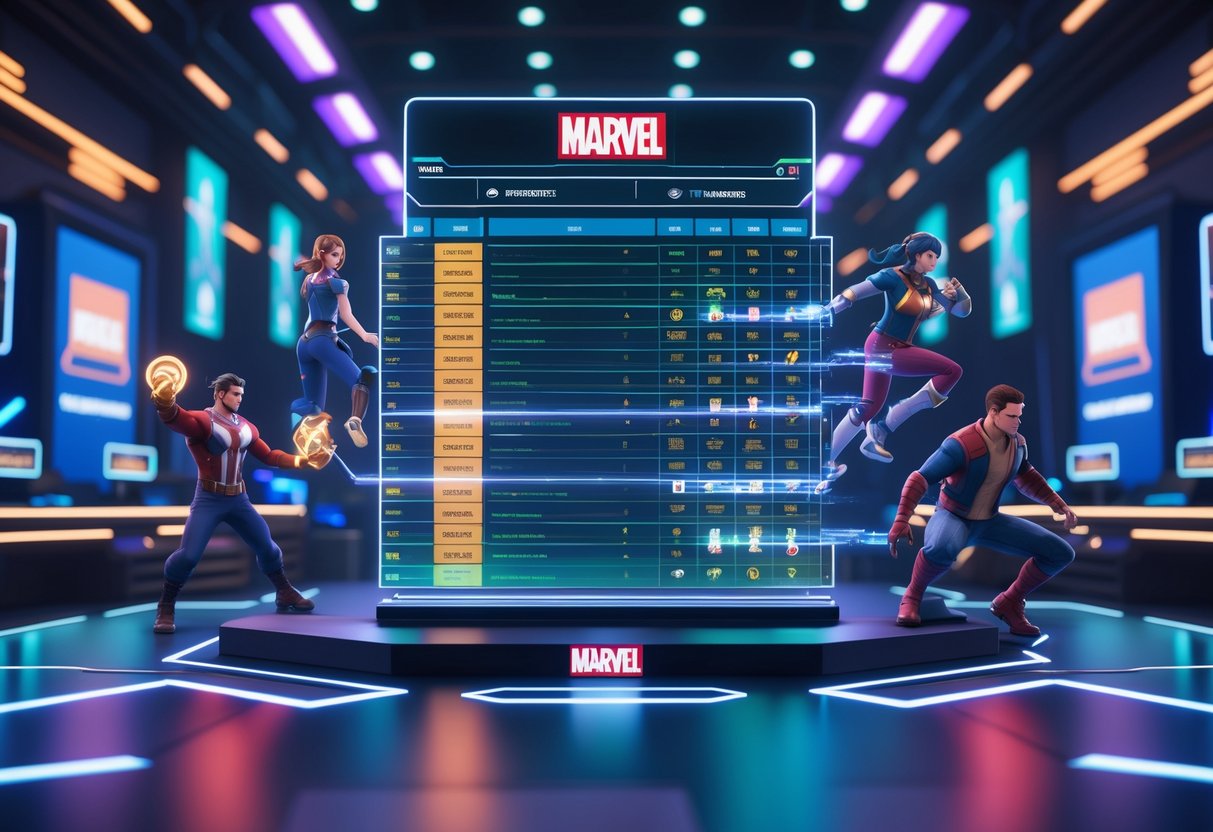
Tournament standings use point systems and tiebreakers when teams finish with the same record. The Marvel Rivals Championship sticks to these rules for every quarterly event to keep things fair.
Points System
Win/Loss Points Every match win gets your team 3 points, and losses get you nothing. This system pushes teams to play for the win, not just to play it safe.
Draws don’t really happen—Marvel Rivals matches go until someone wins.
Map Differential Scoring Map scores matter, too. If you win 2-0, you get a better ranking than someone who wins 2-1, even if you both win the same number of matches.
Map differential is maps won minus maps lost. So, a team with three 2-0 wins sits at +6, while three 2-1 wins put you at +3.
Bonus Point Systems Some organisers give out bonus points for things like shutouts or wild comebacks. Usually, though, Marvel Rivals keeps bonus points low to avoid skewing the competition.
Tie Resolution Methods
Head-to-Head Records If teams have the same points, whoever won their direct matchup ranks higher. This only works if two teams are tied and have played each other.
Map Win Percentage For bigger ties, or if head-to-head isn’t possible, organisers use map win percentage. Divide total maps won by maps played to get the number.
So, 12 wins out of 16 maps (75%) beats 10 out of 14 (71.4%).
Additional Tiebreakers If teams are still tied, officials look at time-based stats—like average match time or total damage. If that doesn’t settle it, they schedule a playoff match if there’s time.
Prizes and Awards
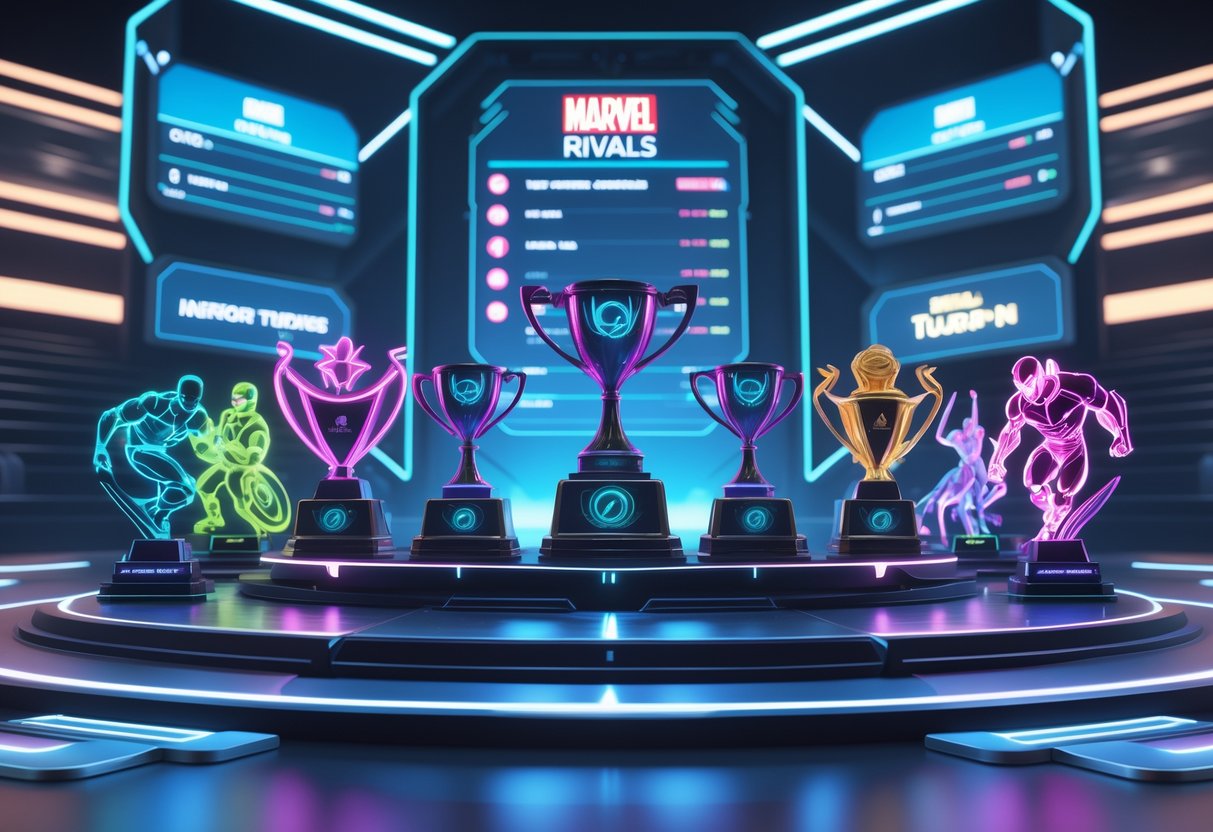
Prize pools in Marvel Rivals tournaments can be all over the place depending on the event. The Marvel Rivals Championship gives out £11,500 per region, but Marvel Rivals Ignite brings a gigantic £795,000 prize pool for the grand finals.
Prize Pool Distribution
The Marvel Rivals Championship splits £11,500 among America, EMEA, Pacific, and China. Each regional winner grabs the biggest chunk.
Season 2: Hellfire Gala sticks to the same prize structure. Teams have to reach the double elimination bracket to get any cash.
Marvel Rivals Ignite raises the stakes with its £795,000 total pool. The grand finals alone pay out that full amount to the top teams.
Prize splits usually follow esports standards:
- 1st place: 40-50%
- 2nd place: 20-25%
- 3rd-4th: 10-15% each
- Other spots: Share what’s left
Some smaller tournaments just hand out in-game items or hardware instead of money.
Delivery of Awards
Winners get their prize money within 30-60 days after the tournament ends. You’ll need to fill out tax forms and verify your info before the payout.
Physical awards include trophies for champions and runner-ups. Major tournaments usually hand out medals or plaques to each team member.
In-game rewards like exclusive MRC sprays go out automatically to all registered players, no matter where they finish.
Payment methods depend on the region and organiser. Most teams get their money via bank transfer or PayPal to the captain, who then splits it up.
Sometimes winners have to do media interviews or promo appearances before they get the full amount.
Conduct and Fair Play Policies
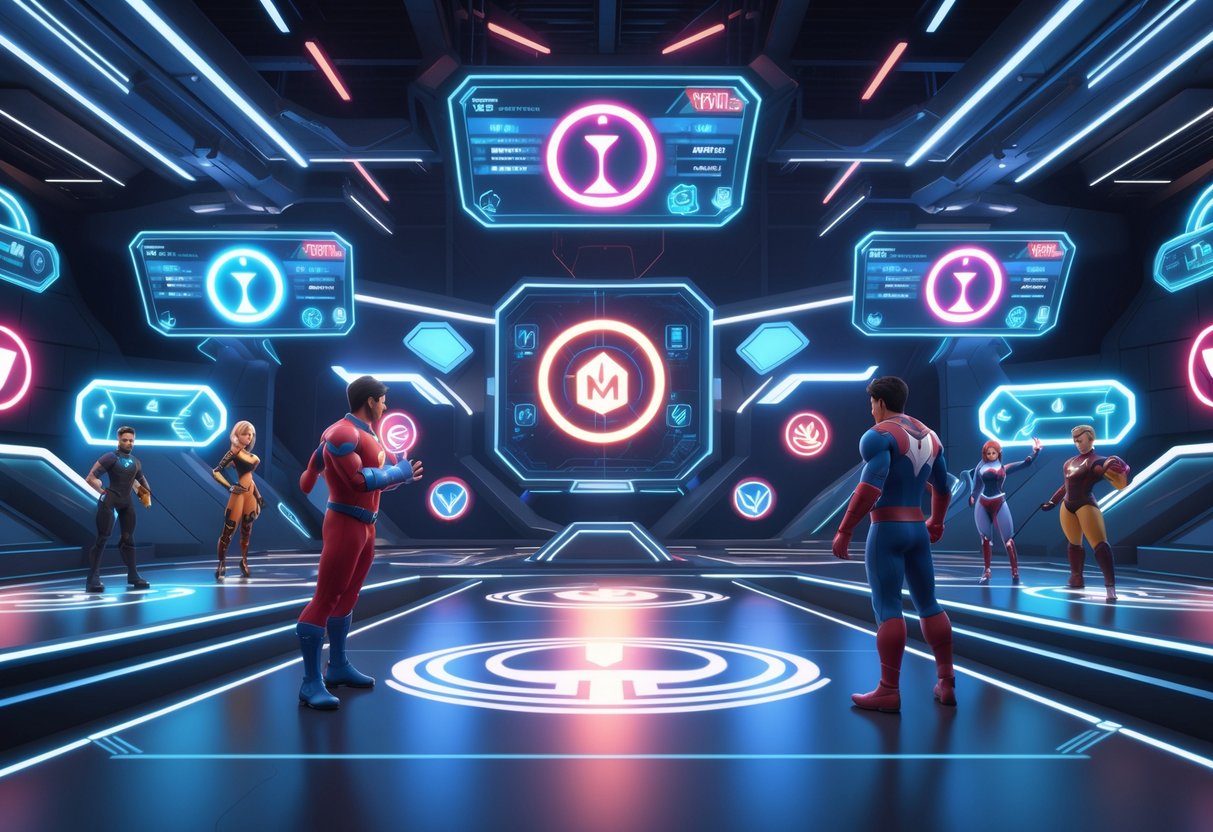
Marvel Rivals tournaments expect everyone to follow strict conduct and sportsmanship rules. Organisers have the final say on discipline and can disqualify teams for breaking the rules.
Code of Conduct
Every player has to link their Marvel Rivals account to their tournament profile before playing. You need an active, good-standing account to get in.
Not allowed:
- Harassing or being toxic to other players
- Using offensive language in chat or voice
- Cheating or exploiting bugs
- Sharing inappropriate stuff during matches
Teams caught breaking these rules can get anything from a warning to a full DQ. Tournament admins make the final call.
Account rules:
- Only registered team members can play
- Players must use their own verified accounts
- Marvel Rivals UID has to be linked to the tournament profile
Sportsmanship Expectations
Organisers want everyone—players, spectators, staff—to act professionally all tournament long.
What’s expected:
- Show up on time with your full team
- Talk to opponents and officials respectfully
- Accept referee decisions without arguing
- Follow all equipment and streaming rules
If you don’t have enough players at match time, your team forfeits. It’s smart to register backups just in case.
Teams also need to follow any livestreaming or equipment rules for their event. Each Marvel Rivals Championship might tweak the conduct standards, so read the latest rulebook before you play.
Streaming, Media and Spectator Experience
Marvel Rivals tournaments give fans a bunch of ways to watch matches live through official streaming platforms. You’ll find exclusive videos and interactive features to make the viewing experience better.
How to Watch on YouTube and Twitch
Every Marvel Rivals Championship match streams live on the official YouTube and Twitch channels. These are the main places to catch all the action.
Both platforms show the same matches. YouTube usually has higher video quality and lets you scrub through the timeline easily. Twitch is better for chat and hanging out with the community.
Viewing Schedule:
- Regional matches: Live on both
- Grand Finals: Full production, all the bells and whistles
- VODs: Available after matches finish
Marvel Rivals Ignite uses the same channels. The $1 million Grand Finals get top-tier coverage with extra camera angles and expert casters.
Quick tip: Follow both channels to get live notifications. That way, you won’t miss any big games.
Featured Content and Interactivity
Marvel Rivals comes with built-in spectator tools. The game includes a spectator mode with about a 40-second delay for competitive fairness.
In-Game Spectating Options:
- Open to All: Anyone can watch your custom games
- Friends Only: Restricts who can watch
- Tournament Broadcasting: Special tools for official streams
Competitors get exclusive MRC sprays as participation rewards. Right now, viewer drops and special esports activations aren’t available during streams.
The spectator system tries to balance giving viewers a good look with keeping things fair for players. You get solid camera angles, but you won’t see anything that would give away strategies in real time.
If you’re new, start with the official streams—they offer more context and commentary. Once you get the hang of it, you can check out in-game spectating for a closer look at the action.
Notable Events and Invites
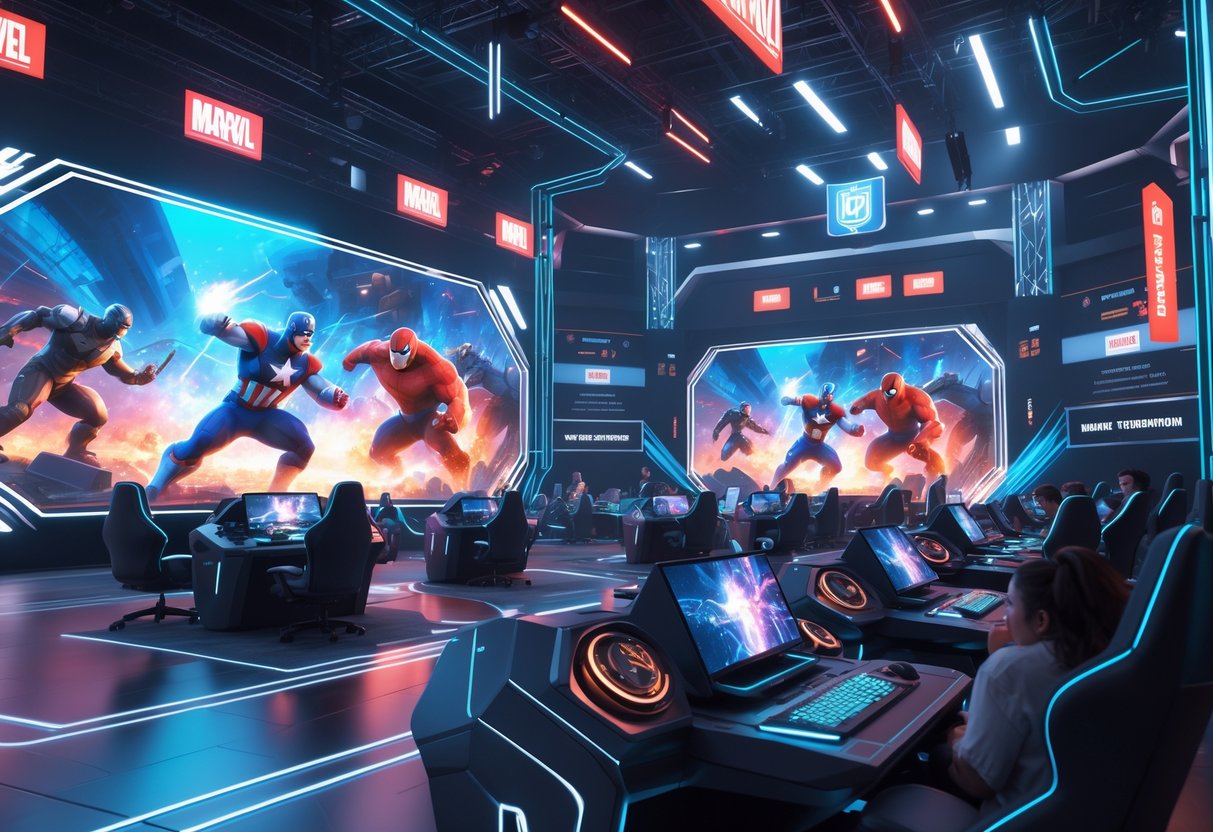
Marvel Rivals runs several high-profile tournaments that highlight top teams from around the world. The Hellfire Gala stands out as the game’s big annual championship.
Seasonal invitationals pop up throughout the year, giving competitors plenty of chances to jump in.
Hellfire Gala Overview
The Hellfire Gala is Marvel Rivals’ main event. Every year, the best teams from every corner of the globe gather for the ultimate competitive showdown.
Prize pools at these events can get pretty wild. For example, the Marvel Rivals Ignite Grand Finals puts up a $1 million prize pool, which puts it among the richest hero shooter tournaments out there.
Teams fight their way in through regional qualifiers or by climbing seasonal rankings. Usually, the format starts with group play and then moves into knockout rounds.
What really sets the Hellfire Gala apart is its mix of intense competition and flashy production. Teams aren’t just chasing cash—they want that world champion title.
Seasonal Specials and Invitationals
You’ll see invitationals pop up on the calendar all season long. The Marvel Rivals Invitational (MRI) NA is a good example.
Tournament Structure:
- Swiss System Stage (March 14-16)
- Double-Elimination Stage (March 21-23)
- Top teams from all over North America
Organizers use formats that have already proven themselves in other esports. The Swiss system means every team gets a few matches, and the double-elimination finish lets underdogs fight their way back.
Marvel Rivals Ignite tournaments show up regularly, too. The format changes depending on how many teams sign up, which keeps things interesting.
Teams can qualify in a few ways—seasonal championships, regional tournaments, or sometimes direct invites if they’re high enough in the rankings.
Frequently Asked Questions
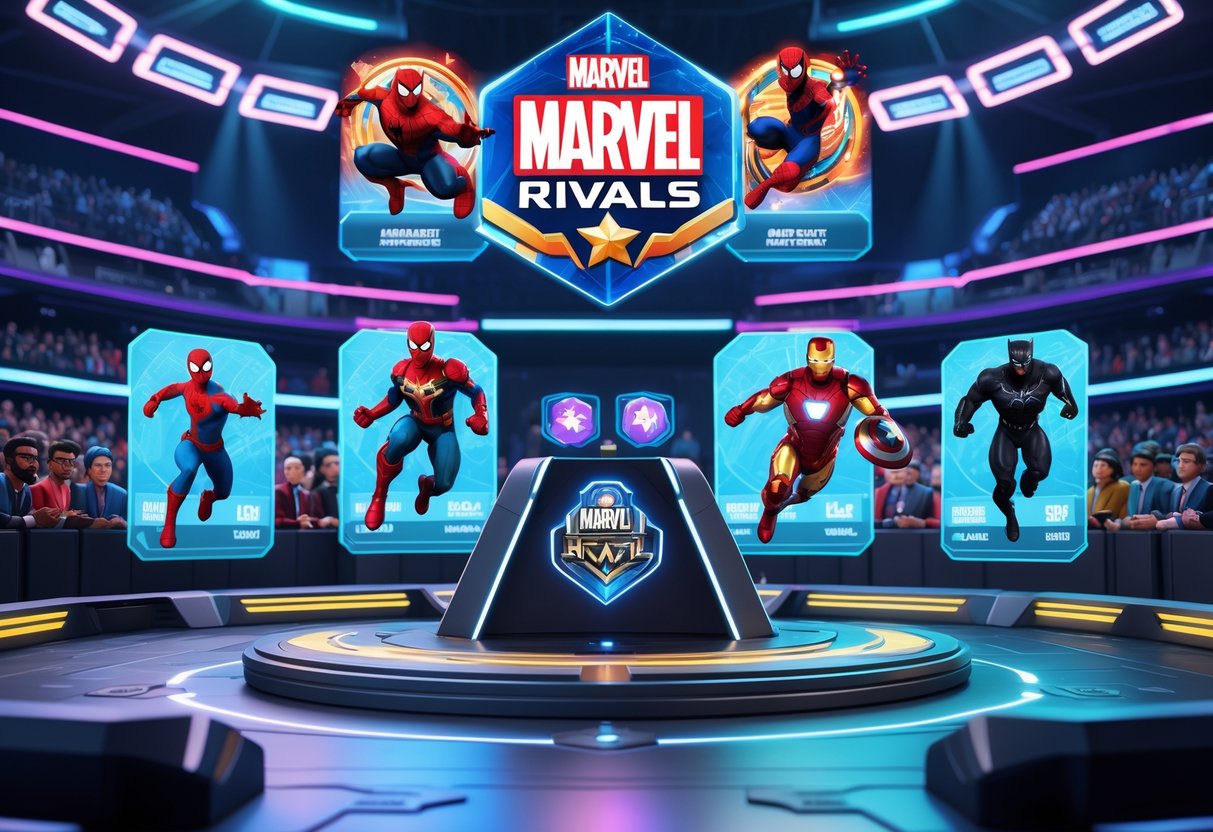
Marvel Rivals tournaments have their own eligibility rules and run on a quarterly schedule. The rules might change from season to season, and prize pools aren’t always the same in every region.
What are the latest rules for participating in a Marvel Rivals tournament?
To play, you need an active Marvel Rivals account in good standing. Only players listed on the team and using their own accounts can compete.
Everyone has to sign a participation confirmation form, either on paper or electronically, before the tournament starts.
Only the Tournament Organiser or Event Administrators can update the rules. They’ll change things up if it’s best for the tournament.
Could you tell me about the prize pool for the upcoming Marvel Rivals tournament?
Prize pools can vary a lot between Marvel Rivals tournaments. The Championship offers different rewards depending on where you play and the level of the event.
Check the official rules for your region for the latest details. Prize amounts and rewards can shift from one event or season to another.
If you want the most up-to-date info, reach out to the tournament organisers directly. That way, you’ll get the details that matter for your event.
How does the tournament format differ between Season 1 and Season 2 of Marvel Rivals?
The Marvel Rivals Championship runs on a quarterly basis, and the format might change each season. Sub-titles, rules, and how you register can all be different.
Organisers tweak the format based on game updates and what’s balanced competitively. The 20250415 patch, for example, brought changes to the customisable tournament feature.
You’ll want to check the latest tournament rules for your season. Previous formats might not work for the current competition.
What are the key requirements for players looking to join a Marvel Rivals tournament?
Players need a Marvel Rivals account that’s active and free of violations. The account has to be registered specifically for tournament play.
You have to compete under your own account. Sharing accounts or pretending to be someone else is a no-go.
Teams need to register all their members properly. Each player has to finish the participation confirmation before jumping in.
When is the next Marvel Rivals tournament scheduled to take place?
The Marvel Rivals Championship sticks to a quarterly schedule, matching the game’s seasonal rhythm. That means there are frequent chances to compete.
The tournament series runs across seven regions worldwide. Each region may set its own dates based on local needs.
For exact dates, check the official Marvel Rivals Championship website. They usually announce schedules a few weeks ahead of time.
Are there any notable changes in the tournament rules for Marvel Rivals in 2025?
The April 2025 patch brought some updates to the in-game customizable tournament feature. Now, tournament organizers have more control over how they set up and run their events.
Tournament broadcasting rules got a tweak too. Only select qualifying matches get broadcast live, while the semi-finals and finals always get full live coverage.
Cross-platform play finally works for tournaments. Players on any platform can join the same private matches and compete together.


